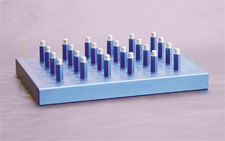Archival Notice
This is an archive page that is no longer being updated. It may contain outdated information and links may no longer function as originally intended.
The use of magnetic beads is another solid phase extraction method.
These methods:
- Can be automated
- Increase throughput
- Demonstrate the ability to remove amplification inhibitors
- Use no hazardous chemicals.
These kits can also be used as adjuncts to traditional methods, when additional clean-up is warranted.
The principle underlying magnetic bead procedures involves attracting DNA to magnetic beads, holding the beads in place using a magnetized source, such as a rack or tube holder, and washing away other components of the sample.
Invitrogen's ChargeSwitch® Technology (CST®) involves the use of magnetic beads whose surface bears a charge that can be switched based on the pH of the surrounding buffer environment. At low pH, the beads are positively charged, attracting the negatively charged DNA molecules and allowing proteins and contaminants to be removed by washing.
See the YouTube Terms of Service and Google Privacy Policy
The DNA IQ™ System by Promega uses silica-coated magnetic beads. DN™ was designed for automation on robotic systems. The quantity of beads used in the procedure defines the binding capacity, which is approximately 100ng of DNA. This relative quantitative capability makes it ideal for databasing and paternity applications because consistent quantities of DNA are isolated. The DNA IQ™ kit contains the proprietary resin and several specialized buffers, including lysis, wash, and elution.
The EZ1™ System by Qiagen also uses silica-coated magnetic beads and designed to be used with a proprietary EZ1 robot. Large quantities of genomic DNA can be recovered and the robots have capacity to process up to 14 samples at one time. Traditional extraction programs are loaded on the robot, but they can also be customized to a specific laboratory need such as samples with large volumes. The EZ1™ kit contains the proprietary beads and several specialized buffers, including lysis, wash, and elution all pre-loaded in a strip that can be easily inserted into the robot.
Additional Online Courses
- What Every First Responding Officer Should Know About DNA Evidence
- Collecting DNA Evidence at Property Crime Scenes
- DNA – A Prosecutor’s Practice Notebook
- Crime Scene and DNA Basics
- Laboratory Safety Programs
- DNA Amplification
- Population Genetics and Statistics
- Non-STR DNA Markers: SNPs, Y-STRs, LCN and mtDNA
- Firearms Examiner Training
- Forensic DNA Education for Law Enforcement Decisionmakers
- What Every Investigator and Evidence Technician Should Know About DNA Evidence
- Principles of Forensic DNA for Officers of the Court
- Law 101: Legal Guide for the Forensic Expert
- Laboratory Orientation and Testing of Body Fluids and Tissues
- DNA Extraction and Quantitation
- STR Data Analysis and Interpretation
- Communication Skills, Report Writing, and Courtroom Testimony
- Español for Law Enforcement
- Amplified DNA Product Separation for Forensic Analysts


